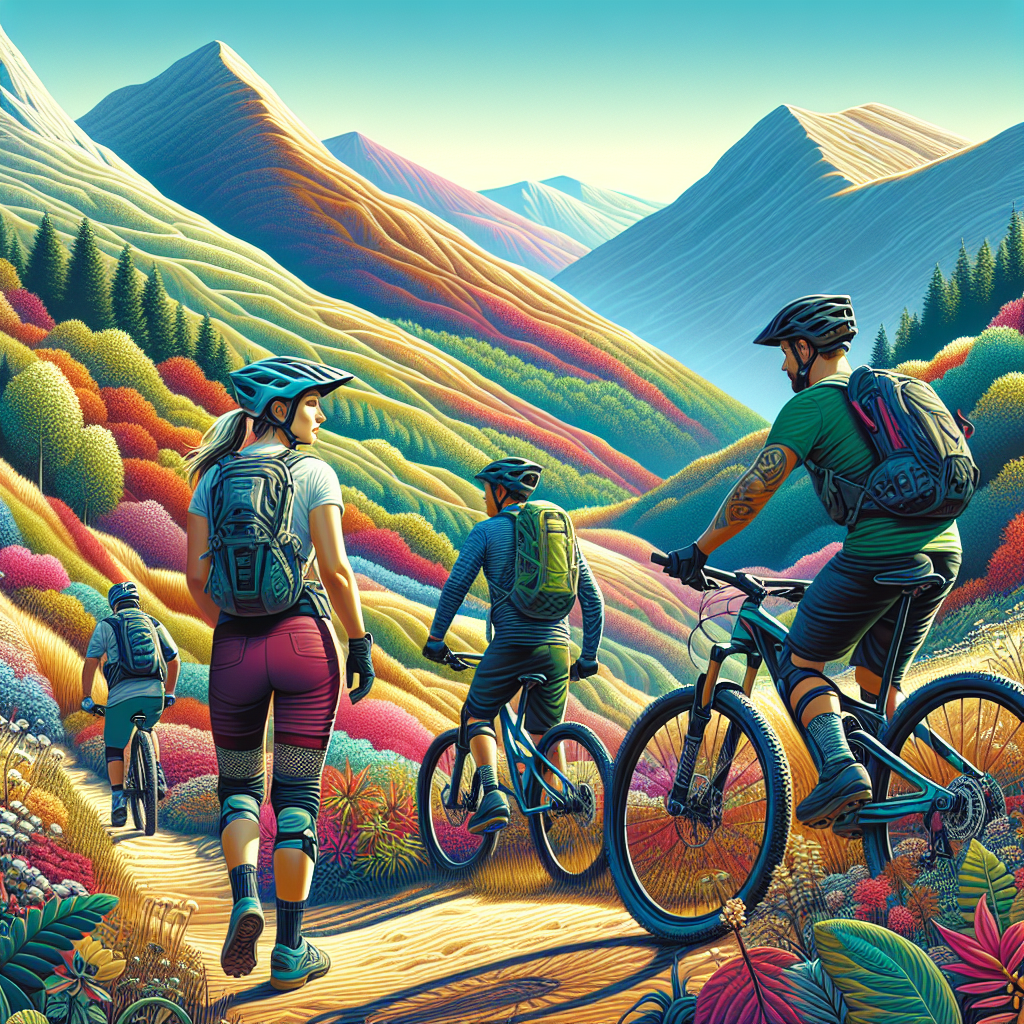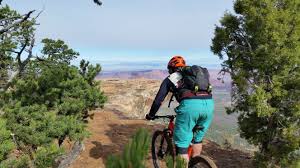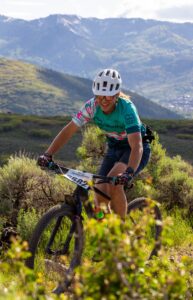
Mountain biking isn’t just for the young and reckless; it’s a sport that can be embraced at any age, and I’m here to show you how. If you’re over 60 and looking to hit the trails, you’ve come to the right place. Let’s gear up and roll into the world of mountain biking together, where the fresh air and thrill of the ride are ageless.
Now, before we dive into the nitty-gritty, let’s take a moment to appreciate why mountain biking is such an excellent activity for seniors. It’s not only about the adrenaline rush—though that’s a nice bonus—it’s about improving your heart health, strengthening your body, and keeping your mind sharp. Plus, it’s a fantastic way to connect with nature and meet like-minded folks.
Embarking on a Mountain Biking Journey After 60
So, you’re intrigued by the idea of mountain biking? Excellent! The first step is to ask yourself what kind of rider you want to be. Do you envision yourself cruising down smooth trails, or does the challenge of a rocky path excite you? Your answer will guide everything from the bike you choose to the trails you tackle.
- Understand your fitness level and how it aligns with different biking styles.
- Research the types of trails that match your riding preference.
- Consider taking a beginner’s course to get comfortable on the bike.
- Start with easier trails and gradually build up to more challenging rides.
- Always prioritize safety, especially when trying out new terrains.

Next, let’s talk about the benefits of mountain biking, specifically for seniors. The cardiovascular exercise is fantastic for heart health, and the low-impact nature of the sport means it’s kind on your joints. But it’s not just about the physical; the mental boost you get from navigating trails and soaking in the outdoors is invaluable.
Physical and Psychological Benefits of Mountain Biking for Seniors
Mountain biking is a powerhouse of health benefits. It gets your heart pumping, which can improve cardiovascular health by 3-7 percent. That’s a big deal since heart disease is a leading cause of death among seniors. Plus, the focus required on the trails can help keep your mind sharp and potentially stave off cognitive decline.
But there’s more. The sense of accomplishment from mastering a new skill or trail is a real confidence booster. And let’s not forget the social aspect—joining a community of riders can be a game-changer for your social life and overall happiness.
Examining Risks and Overcoming Fear
It’s natural to worry about the risks, especially when trying something new like mountain biking. Falls can happen, but with the right approach, they can be minimized. As a senior, it’s crucial to be mindful of injury prevention and to ride within your limits.
“The brave may not live forever, but the cautious do not live at all.” – Unknown
That said, being brave doesn’t mean being reckless. It’s about finding the balance between pushing your boundaries and staying safe. Wearing the right gear, choosing appropriate trails, and knowing your body’s limits are all part of the equation.

Key Takeaways
Before we move on, let’s quickly recap what we’ve covered so far:
- Mountain biking is a fantastic way for seniors to stay active and engaged.
- It’s important to identify what type of rider you are to tailor your experience.
- The health benefits of mountain biking extend beyond physical fitness to mental acuity.
- Risks are present, but with the right precautions, they can be managed effectively.
- Embracing the challenge of mountain biking can lead to newfound confidence and joy.
As we continue, remember that mountain biking is a journey, not a race. It’s about personal progress, enjoying the outdoors, and building a community. So, let’s keep the wheels turning and explore how to customize your cycling experience to get the most out of every ride.
Choosing the Right Mountain Bike for Seniors
When it comes to mountain bikes, one size does not fit all. As a senior, you want a bike that’s comfortable, easy to handle, and forgiving on the joints. Look for bikes with a lower standover height for easier mounting and dismounting, and consider models with front suspension to absorb those bumpy trails.
- Opt for a lightweight frame for easier maneuverability.
- Adjustable components like the seat and handlebars can help achieve the perfect fit.
- Test ride different bikes to see what feels best for your body and riding style.
- Don’t shy away from asking for advice at your local bike shop—they’re there to help!
Remember, the right bike will feel like an extension of yourself, so take your time in choosing the perfect ride.
Essential Gear for Comfort and Protection
Now, let’s gear up! Protection is paramount, so invest in a high-quality helmet that fits well. Gloves will protect your hands and improve grip, while padded shorts can make all the difference on longer rides. And don’t forget about your eyes—dust, debris, and sunlight are no match for a good pair of cycling glasses.
- Helmet: Look for one with MIPS technology for added protection.
- Gloves: Choose full-fingered for better coverage.
- Padded shorts: They’re a lifesaver for your sit bones on rough terrain.
- Cycling glasses: Ensure they have UV protection and are shatterproof.
- Hydration pack: Staying hydrated is key, so carry water with you.
With the right gear, you’ll be comfortable, protected, and ready to tackle any trail that comes your way.

Finding Your Pace in the Great Outdoors
Mountain biking is not a race—it’s about finding your rhythm with the trail. Start at a pace that feels comfortable and focus on enjoying the ride. It’s okay to take breaks, admire the scenery, and listen to your body. This is your adventure, and there’s no need to rush.
As you gain confidence and strength, you’ll naturally find your pace increasing. But the goal is always to ride sustainably, so you can keep enjoying the trails for years to come.
Starting Small: Trail Types and Difficulty Levels
Every trail has its own personality, and it’s wise to start with ones that are more forgiving. Look for well-maintained trails with clear signage indicating difficulty levels. Green trails are typically the easiest, followed by blue, then black for the more advanced riders.
- Green trails: Great for beginners, often with minimal obstacles.
- Blue trails: Offer a bit more challenge with some elevation changes and obstacles.
- Black trails: Best left for when you’re confident in your skills and fitness.
Remember, there’s no shame in starting small. The most important thing is to have fun and stay safe.
Navigating Terrain: Weather and Environmental Considerations
Weather and the environment play a big role in mountain biking. Always check the forecast before heading out and be prepared for changes in weather. Wet trails can be slippery, while hot weather demands extra hydration.
- Wet conditions: Slow down and be cautious of slick surfaces.
- Heat: Wear breathable clothing and apply sunscreen.
- Cold: Layer up and protect extremities with warm gloves and shoe covers.
- Wildlife: Be aware of your surroundings and know how to react to animals you might encounter.
Respect the trails and the environment by staying on marked paths and practicing Leave No Trace principles. This way, we can all enjoy the beauty of the outdoors for generations to come.
Training Strategies for the Senior Rider
Training is essential, especially as a senior rider. Your focus should be on building endurance and balance, which are crucial for tackling those trails. You don’t need to train like a pro, but incorporating regular exercise into your routine will make a significant difference in your riding experience.
Exercise Routines to Enhance Endurance and Balance
To boost your endurance, consider activities like walking, swimming, or stationary cycling. These exercises are gentle on the body while effectively building stamina. For balance, yoga and tai chi are excellent choices. They’ll help you stay nimble and confident on your bike.
- Walk regularly to build up leg strength and cardiovascular health.
- Swim for a full-body workout that’s easy on the joints.
- Use a stationary bike to mimic cycling movements and improve pedaling efficiency.
- Practice yoga to enhance balance and flexibility.
- Try tai chi for its gentle movements and focus on stability.
Consistency is key. Aim to exercise several times a week, and you’ll notice improvements not just on the bike, but in your daily life as well.
Mobility Work and Injury Prevention
Mobility work is often overlooked, but it’s a game-changer for preventing injuries. Stretching before and after rides keeps your muscles flexible and your joints happy. Focus on areas that get tight from cycling, like the hips, hamstrings, and lower back.
- Dynamic stretches before riding to warm up your body.
- Static stretches after your ride to maintain flexibility.
- Incorporate foam rolling to release muscle tightness.
- Strengthening exercises for your core can prevent back pain.
- Balance exercises, like standing on one leg, can improve your stability on the bike.
Remember, injury prevention is about listening to your body. If something doesn’t feel right, give yourself time to rest and recover.

Smart riding is about combining skills with safety measures. As a senior, it’s especially important to ride smartly to enjoy the trails without unnecessary risks. Take the time to learn basic techniques and always ride with a safety-first mindset.
Basic Techniques for Handling Your Mountain Bike
Handling your bike with confidence comes down to mastering a few key techniques. Start with learning how to position your body during climbs and descents. Keep your weight centered over the bike, and use your arms and legs as shock absorbers on rough terrain.
- Learn the ‘attack position’ for better control on technical sections.
- Practice shifting your weight to navigate turns smoothly.
- Brake evenly with both front and rear brakes to avoid skidding.
- Keep your eyes ahead on the trail to anticipate obstacles early.
- Use gear shifting to your advantage to maintain a steady cadence.
These techniques might take some practice, but they’ll become second nature with time. And when they do, you’ll feel like a true mountain biker, ready for whatever the trail throws your way.
Safety Protocols and Emergency Preparedness
When it comes to mountain biking, safety is not an afterthought—it’s a priority. Always let someone know where you’re going and when you expect to return. Pack a basic first aid kit, a multi-tool for bike repairs, and a charged cell phone. It’s also wise to familiarize yourself with the signs of heat exhaustion and hypothermia, just in case.
- Inform a friend or family member of your ride plans.
- Carry identification and emergency contact information on you.
- Learn basic first aid and CPR.
- Keep a whistle and a small flashlight or headlamp in your pack.
- Consider a GPS device or app to track your route.
By being prepared for emergencies, you’ll have peace of mind and can focus on the joy of the ride.
Joining the Community
Mountain biking is more than just a sport; it’s a community. Joining a group of fellow riders can offer support, knowledge, and camaraderie. It’s a chance to share stories, tips, and maybe even a post-ride coffee or meal. The shared experience of riding can forge friendships that last a lifetime.
Clubs and Groups: Finding Support and Camaraderie
Look for local mountain biking clubs or groups that welcome riders of all levels. These organizations often organize rides, offer workshops, and advocate for trail maintenance. Being part of a club can also provide motivation to ride regularly and explore new trails.
- Search online for local biking clubs or ask at your local bike shop.
- Attend club meetings or social events to get to know other members.
- Volunteer for trail work days to give back and learn about trail upkeep.
- Participate in group rides that match your skill level and interests.
- Don’t be afraid to ask questions—most bikers love to share their knowledge.
Embrace the social aspect of mountain biking and enjoy the ride with others who share your passion.
Organizing Group Rides with Fellow Senior Bikers
If you can’t find an existing group that fits your needs, why not start your own? Organizing group rides with fellow senior bikers can be incredibly rewarding. It’s a great way to ensure the rides are tailored to your group’s pace and preferences.
- Use social media or community boards to connect with other senior riders.
- Plan routes that are suitable for the group’s skill level.
- Set a regular schedule for rides to build consistency and anticipation.
- Assign roles within the group, like a lead rider and sweep, to ensure no one gets left behind.
- After the ride, gather feedback to make the next outing even better.
Leading a group can be as fulfilling as the ride itself, and you’ll be creating a welcoming space for seniors to enjoy mountain biking together.
Planning for Progression
As you continue your mountain biking journey, it’s important to plan for progression. This doesn’t mean pushing yourself to the extreme; it’s about setting achievable goals and gradually expanding your skills and endurance. Celebrate the small victories along the way—they add up to significant achievements.
Maybe your goal is to tackle a longer trail or to ride more frequently. Whatever it is, keep it realistic and within reach. Progression is personal, and it’s not a competition. It’s about improving at your own pace and enjoying every pedal stroke along the way.
- Set specific, measurable, achievable, relevant, and time-bound (SMART) goals.
- Track your rides and progress with a journal or biking app.
- Seek feedback from more experienced riders to refine your technique.
- Celebrate milestones, no matter how small they may seem.
- Stay patient and persistent—the rewards are worth it.
Remember, the journey of mountain biking is as rewarding as the destination. Keep pedaling, keep exploring, and most importantly, keep enjoying the ride!
Setting Realistic Goals and Milestones
When it comes to setting goals, the key is to keep them realistic and achievable. This ensures you stay motivated and enjoy the process without getting discouraged. Think about what you want to accomplish with your mountain biking—whether it’s increasing the distance you can ride, mastering a particular trail, or simply getting out there more often.
- Start with short-term goals that you can achieve relatively quickly.
- Break down larger goals into smaller, more manageable steps.
- Be flexible and adjust your goals as needed based on your progress and how you feel.
- Remember to celebrate every success, no matter how small—it’s all part of the journey.
By setting milestones along the way, you’ll be able to see just how far you’ve come and stay excited about the road ahead.
Tracking Improvements in Performance and Stamina
Seeing yourself improve is one of the most rewarding parts of mountain biking. Keep track of your rides and monitor your performance to see the progress you’re making. This can be as simple as noting down how you felt during a ride, the distance you covered, or how often you’re getting out on the trails.
- Use a fitness tracker or app to record your rides and see your improvement over time.
- Take note of how you feel after each ride—less fatigued, more energetic, etc.
- Pay attention to how your bike handling skills are advancing with each outing.
- Set periodic check-ins with yourself to reflect on your progress and reassess your goals.
Tracking your performance not only shows you how much you’ve improved but also helps you identify areas where you can still grow.

FAQs for Senior Mountain Bikers
Can I start mountain biking if I have never biked before?
Absolutely! It’s never too late to start mountain biking. Begin with the basics, like getting comfortable on a bike and learning how to balance and pedal. Then, move on to easy trails and gradually build your skills from there. Remember, everyone starts somewhere, and the mountain biking community is supportive of newcomers.
- Consider taking a beginner mountain biking class to learn in a safe environment.
- Practice on flat terrain before moving to gentle slopes.
- Go at your own pace and don’t compare yourself to others—everyone’s journey is unique.
With patience and practice, you’ll be hitting the trails with confidence in no time.


